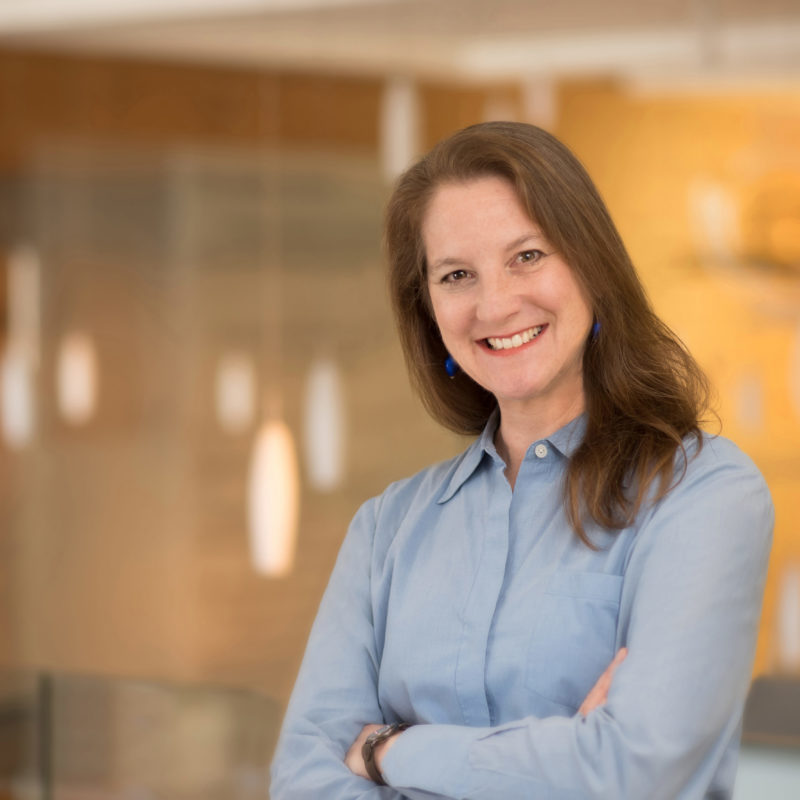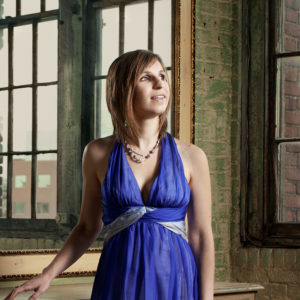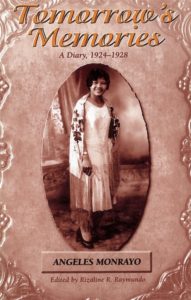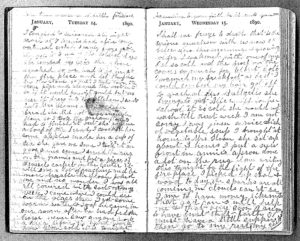
The first world premiere commission of ROCO’s 15th season “Coming Of Age,” takes audiences back in time for a poignant glimpse into the everyday lives of five American women, giving voice to their unique yet unknown experiences for the first time – in Lisa Bielawa’s Centuries in the Hours, written for mezzo-soprano Laurie Rubin.
In this ROCOInsider, we chatted with Lisa to learn how the serendipitous discovery of these personal writings inspired the work, why Laurie is the perfect partner to bring them to life, and to explore how musical performance can make visible – the invisible.
The story behind Centuries in the Hours actually starts in a library – a very special one. Tell us about where these writings were discovered?
I had applied to become a William Randolph Hearst Visiting Artist Fellow at the American Antiquarian Society in Massachusetts, in research for another piece based on the writings of Mary Maclane, a fascinating young memoirist active at the turn of the century.
While there I found they had access to this incredible archive of women’s personal writings from the 18th-20th centuries – many housed in the libraries of women’s colleges, diaries that had been donated often by their families – and I just could not put them down. I read the writings of 72 women in all! I discovered this whole other world, feeling like I was getting this entirely different version of American history, through the eyes of these women.
This was in July of 2018, and I already knew I’d be working on a commission for ROCO with singer Laurie Rubin – so by the time I left at the end of my fellowship month, I knew that this was the piece I was going to write.
Although her writings are not part of this work’s text, the title does come from Mary Maclane – how does it tie together the experiences of these five women?
The title is directly from Mary’s memoir – in 1901, she wrote, “When my happiness is given me, I shall live centuries in the hours.” I think that’s such a beautiful phrase, in fact I get goosebumps saying it – because that’s the feeling I got reading these diaries, of being the one waiting at home while men went out to work or to war, all those hours endured – of reading, sewing, and all that happens in home life – and it’s a very different view of history than what I was taught growing up.
I’m age 50, and in school, I was taught about wars, and the dates men signed things – but what was 51% of the population doing? Aside from perhaps Betsy Ross, you just don’t hear about these women at all, unless you go do your research, dig in and read about them.
So I fell in love with this idea, of “I will live centuries in the hours,” and that this expresses the timelessness of women’s experience as told by Mary Maclane so many years ago – Mary, who was this striking, amazing, unusual American woman who came out of nowhere, and burst on the scene with her writing. And then look at Laurie, who will sing their words – who is another striking, amazing, unusual American woman too, much like Maclane.
You have worked with Laurie on a previous project – when did you first meet, and how did your collaboration come about?

I first met Laurie way back in 2003, at a workshop put on by Dawn Upshaw for young singers and composers to have a chance to work together. When Laurie performed, there was this incredible, palpable feeling – you could just feel the level of nonvisual, musical communication rise in the room. I’ve wanted to work with her ever since, it just took quite a while to make it happen – and we did finally in 2017 with my made-for-TV opera Vireo: The Spiritual Biography of a Witch’s Accuser.
How closely did you work with Laurie during the writing of “Centuries in the Hours”?
We were in touch some, but I knew her voice really well from our work together on Vireo, and I’m a singer too, so that helps in the writing. I saw this piece as an opportunity to celebrate all I already knew she could do. In Vireo, she played one large role, a part of a much bigger picture, but here – she plays five different roles! So I had much greater freedom to bring out all sides of her gift, and she’s one of those singers – where the voice, her instrument, is just so amazing.
Out of 72 women’s writings – how did you narrow it down to the 5 women whose words we will hear?
There were three aspects of the diaries I looked at primarily, to approach narrowing it down.
First, I wanted diversity in the writings – racial, geographic, historic diversity, and to the degree I could – age diversity – although most of what I found was written by young women, in their teens or twenties.
That narrowed it down quite a bit. And then I wanted to find, of course – language that is just breathtakingly beautiful, that would be beautiful to sing. Finally, I wanted a range of kinds of experiences, of backgrounds – of life circumstances.
So, I ended up with women from four different states, and one woman on a ship going around the Cape – which was Betsey Stockton, a 25-year-old freed slave in 1823, serving as a missionary! Her writings were published in the Christian Advocate, a newsletter from the early 19th century, and perhaps the only reason that they survived.
And then, we have Emily French – found from the archives of Colorado College, who is 38 years old, writing in the 1890s. What I like about her diaries, and was quite rare that I found, is her experience as someone who was truly dirt poor, divorced, with a child, working herself to the bone, cleaning houses. (Although she does get the happy ending 19th-century style eventually, and did get remarried, bringing her out of economic suffering.)
Then we have our Revolutionary Era wartime girl, Sarah Wister in Pennsylvania, they had moved away from Philadelphia to get away from the fighting – and her perspective is one of basically sitting at home, trying to look pretty, in case a soldier comes by!
It took some doing to find an Asian-American woman, but I did – in Angeles Monrayo Raymundo, a Filipina writing in Honolulu, then in California in the 1920s. A teenager married by the time she was 14, to a 25-year-old man, Angeles was a very excited, hopeful girl looking toward the future – who dearly loved to learn, and was ecstatic to be learning to read and write.
And then last – with the piece being premiered in Texas, I knew I had to have a woman from Texas, and hopefully this area – we have Sallie McNeill, of Brazoria County in the 1860s, the daughter of the owner of a huge plantation.
Gender roles in Confederate households of the time were so strict, you see it in Gone With the Wind – and Sally’s diary is just heartbreaking, actually the saddest of them all, because she was so, so, bored. She has everything, but she just doesn’t see the point – all the vitality of living, it’s all happening elsewhere.
It’s such a stark difference from 2019 – and an amazing window back in time, to realize how far we’ve come, isn’t it?
Oh yes, it’s an incredible contrast – here in 2019, in Houston just miles away from Sallie, we have in ROCO an organization run entirely by women, with women in the orchestra performing on stage, and premiering music written by women – it really does look completely different.
You can truly see these centuries, through the lenses of the individual hours of these women, you can see that expanse of time happening through their frank words.
How does your writing musically portray each of the women and their experiences? Each movement is extremely unique, colorful, and so different in mood.
In such a short work, I only have about 3 minutes for each movement, so it’s really about building a sound world as vividly and boldly as possible right away.
First up, we have Emily – who is completely harried and all over the place, in writing her movement I had her line “Everything is blowing away!” on top of the sheet! So it’s how do I musically give to the orchestra this idea of things flying, almost like Alice In Wonderland – it’s really just a snapshot that stays through the whole movement.
And next we’re with Betsey – and she’s on the ocean, at peace, and the serenity of that – it’s how do you capture that musically.

(Published by Univ. of Hawaii Press)
Then, for Angeles – which is one of Laurie’s very favorite movements – it’s about expressing her thirst for the world, her love of learning, and the wellspring of life and vitality in her. Her experience of coming to America, with an openhearted desire to learn and live, writing here in her second language – it is so very sweet.
For Sallie next – she was seriously depressed, so I wanted this tiny song to break your heart. I felt so much compassion for her, sitting at home like a decoration on a cake, feeling at such a dead-end she just wants to sleep, instead of live.
And then I ended with the earliest one, in Sarah – who I made a march for in ¾, expressing her anticipation as she’s at home waiting, missing the parties before wartime, just hoping she might hear a soldier coming by. Again, with that common feeling of cagedness, of being stuck at home and not being in the world.
It’s quite interesting that of all the women, Betsey is really the one who is most at peace – who is the freed slave, now a missionary, traveling on a ship, with all this hope and anticipation. And in many ways, she ended up being the most fulfilled.
Were some of the movements more challenging to write, and others easier? How long on average did the writing take?
Though all the movements are similar lengths, Sallie was written in 2 days – while Emily took 2 months! And everything else, somewhere in between. And that’s just how it goes as a composer – it’s something you have to leave time for. The range and the varying speed of creation are much, much broader than people realize – I could sit there and stare every day at a blank page for weeks, or then have a dream – and just sit down and it writes itself. For Emily, I knew what I wanted hers to feel like – but the amount of control, the amount of detail that has to go into creating something that feels like it’s out of control, that just takes a great deal of time.
This work is expressly written to be performed without a conductor – what does this mean for the piece, and how it’s written?
The whole piece is conceived that way – it’s all about decentralized leadership among the ensemble. It’s actually kind of poetic I think, as this piece is about decentralized history, coming from five separate women. It truly celebrates Laurie’s expertise, written especially for her skills in nonvisual communication, and the very specialized way of collaborating musically that she brings.
The writing itself is structured so that it’s all about the musicians listening to each other, using a lot of aleatoric material. So instead of worrying about how a section is supposed to stay together without a conductor, I write so that it’s not supposed to be together – it’s creating a cloud of sound instead, meant to unfold organically.
This will be the first time for you to collaborate with ROCO – what excites you about working with us on this commission?
I had been aware of the exciting things ROCO was doing for a while, your innovative programming, and the range. There is so much going on with player-led orchestras right now, and that is something I’m so attracted to – the idea of, instead of trying to get a seat in an orchestra, just making your own. I am super into that spirit and totally identify with it as a collaborator.
For young musicians, especially young women, who might be interested in developing a composing career – what advice would you give?
I actually started composing very young, as my father is a composer, and my mother an early music scholar – so my brother and I just grew up with it, imitating what dad does by bashing around on the piano. It was fun, it was just play – then at some point, it became actual music that you could play. So I just kept on writing.
But then as a young musician, all the composers I saw around me were men, so unfortunately, I never really had a mentor who was a woman. I look at the women in my piece, and I find kinship there.
My advice to young women, and all young people is – if you find yourself outside of what an “accepted” definition of what a composer or a creative person is – to really focus on self-care, and just simply keep on doing it.
I majored in Literature in college – the music professors were all men, so majoring in Music didn’t appeal to me – but I kept writing music under the radar. So I didn’t really break down the door, I snuck under it!
Life is so short – we can be angry or bemoan those doors that weren’t opened, but a better use of the energy is to cycle that frustration into your work – and turn it into ambition, and the power to keep on creating.
 Experience the world premiere of “Centuries in the Hours” – commissioned by ROCO and The ASCAP Foundation Charles Kingsford Fund – in ROCO In Concert: Time For Hope, on Friday, September 27, 2019 at Miller Outdoor Theatre, 8:00 pm (free admission), and Saturday, September 28, 2019, 5:00 pm, at The Church of St. John the Divine. Tickets available at roco.org, or at the door.
Experience the world premiere of “Centuries in the Hours” – commissioned by ROCO and The ASCAP Foundation Charles Kingsford Fund – in ROCO In Concert: Time For Hope, on Friday, September 27, 2019 at Miller Outdoor Theatre, 8:00 pm (free admission), and Saturday, September 28, 2019, 5:00 pm, at The Church of St. John the Divine. Tickets available at roco.org, or at the door.


Leave A Reply